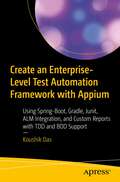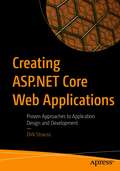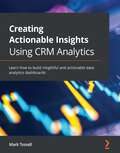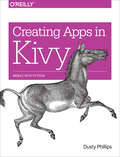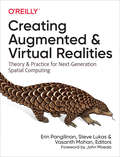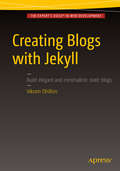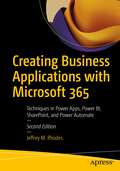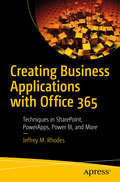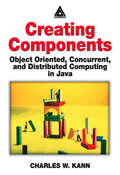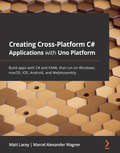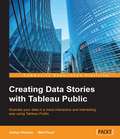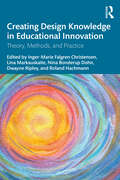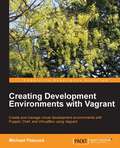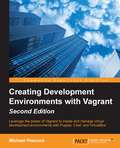- Table View
- List View
Create an Enterprise-Level Test Automation Framework with Appium: Using Spring-Boot, Gradle, Junit, ALM Integration, and Custom Reports with TDD and BDD Support
by Koushik DasThink from a framework design perspective and move beyond straightforward coding skills. You’ll design an enterprise level test framework that is capable of supporting both TDD and BDD at the same time, using the latest open source tools and coding best practices. Taking a less-is-more approach, superfluous information is excised in favor of sleek and direct instruction and focused coding practices.Your framework will be built with Spring-Boot, Gradle, and Junit. And it will support HP QC integration, Allure (TDD, BDD), Extent (BDD), and customized Pdf reporting (TDD, BDD). Extensive utilities are provided, such as HP ALM integration, device management utilities, email reporting, pdf reporting, OCR utility, Log utility, and more! There’s also a special chapter on internationalization/localization testing in multiple languages. After reading this book, you’ll have full confidence in your ability to build new test automation frameworks for yourself. Though primarily written for software professionals who are in test automation, recent engineering graduates who have programming knowledge and want to prepare for a role in mobile test automation will also find what’s taught here helpful. Test engineers and computer science graduates alike can use what they learn here to become absolute pros in test automation.What You'll LearnDesign an enterprise level mobile test automation framework capable of supporting both TDD and BDD Work with the latest open source tools and coding best practices Build with Spring-Boot, Gradle, and Junit while supporting HP QC integration, Allure, Extent, and customized PDF reportingWho This Book Is ForSoftware professionals working in test automation. Recent engineering graduates who have programming knowledge and want to prepare for a role in mobile test automation should also find it helpful.
Create and Deliver a Killer Product Demo: Tips And Tricks To Wow Your Customers
by Oscar SantolallaCreate great product demos and sell more of your product with the strategies and inspiration in this book. Insightful interviews are presented with professionals who are giving killer product demos in several types of businesses today. The strategies taught in this book are based on the analysis of product demos that made history and brought millions to their companies (Apple, Intel, Microsoft, Tesla, and more).Every day thousands of companies give demos to sell their products. In pre-sales for enterprise software a bad demo can make your product look too complex to the point where decision makers won't buy it. In Software-as-a-Service (SaaS) you need to quickly convert signups into active and paying users. At a product launch event you want a perfect demo that is both persuasive and memorable. Remember Steve Jobs?What You'll LearnApply a simple step-by-step method to create effective product demonstrationsKnow the 5 steps to create a wow momentStudy the first exhaustive analysis of product demos that made history: Douglas Engelbart’s Mother of All Demos; Steve Job’s Macintosh, iPod, and iPhone; and many moreAvoid common mistakes and maximize your presence as a technical presenterAlign your demo with your sales process in enterprise software, Software-as-a-Service (SaaS), mobile apps, etc.Be aware of trends in technology for product demosWho This Book Is ForStartup entrepreneurs, sales engineers, executive or sales representatives, and other professionals
Create your Digital Marketing Agency - 14 tips to create your Online Marketing Agency
by Robinson Hardin María José Morales ClementeHow do I create my Online Marketing agency? Where do I start? How much money do I need to have? That is what all entrepreneurs of this Digital Era have asked themselves to start their Online Marketing Agency. With today's technology and access to the internet, a lot of doors are open. A whole world full of possibilities. This book will help you to know a little bit more through these 14 precise tips to start your Online Marketing Agency. Create and start to grow your brand, interact with clients, study your competition, these and a lot more for you to start your Digital Marketing business.
Creating 3D Game Art for the iPhone with Unity: Featuring modo and Blender pipelines
by Wes McDermottRevolutionize your iPhone and iPad game development with Unity iOS, a fully integrated professional application and powerful game engine, which is quickly becoming the best solution for creating visually stunning games for Apple's iDevices easier, and more fun for artists. From concept to completion you'll learn to create and animate using modo and Blender as well as creating a full level utilizing the powerful toolset in Unity iOS as it specifically relates to iPhone and iPad game development. Follow the creation of "Tater," a character from the author's personal game project "Dead Bang," as he's used to explain vital aspects of game development and content creation for the iOS platform. Creating 3D Game Art for the iPhone focuses on the key principles of game design and development by covering in-depth, the iDevice hardware in conjunction with Unity iOS and how it relates to creating optimized game assets for the iDevices. Featuring Luxology's artist-friendly modo, and Blender, the free open-source 3D app, along side Unity iOS, optimize your game assets for the latest iDevices including iPhone 3GS, iPhone 4, iPad and the iPod Touch. Learn to model characters and environment assets, texture, animate skinned characters and apply advanced lightmapping techniques using Beast in Unity iOS. In a clear, motivating, and entertaining style, Wes McDermott offers captivating 3D imagery, real-world observation, and valuable tips and tricks all in one place - this book is an invaluable resource for any digital artist working to create games for the iPhone and iPad using Unity iOS
Creating ASP.NET Core Web Applications: Proven Approaches to Application Design and Development
by Dirk StraussDesign and develop an ASP.NET Core web application using .NET Core 3.0. This book shows you how to publish a web application to a web server and connect the published web application to a production database.Creating ASP.NET Core Web Applications starts by setting up the Visual Studio project where you will learn about Razor pages, Entities, and creating a data service. You will create models along with methods to use a query string and handle bad requests. Modifying data with Tag helpers is discussed as well as installation of Entity Framework, working with database migrations, and implementing a data access service. You will learn how to use layout pages and sections with Partial Views, _ViewImports, and _ViewStart files. You also will create custom middleware and log application events. You will be able to deploy the web application as well as connect it to a SQL Server database.What You Will LearnWork with modelsModify dataWork with EF Core and SQL ServerWork with Razor pages and Partial ViewsUse separate scripts for production vs developmentTrace client-side errors using Chrome Developer toolsCreate cascading style sheets (CSS) with Sassy CSS (SCSS)Explore middlewareDeploy your web application to IISWho This Book Is ForSoftware developers on the .NET stack who want to create ASP.NET Core web applications
Creating Actionable Insights Using Tableau CRM: Learn how to build insightful and actionable data analytics dashboards
by Mark TossellLeverage Tableau CRM to generate valuable business insights and solve business problems efficientlyKey FeaturesExtract, combine, transform, and visualize your data to derive business insights using Tableau CRMGain hands-on experience as you walk through practical dashboard use cases in Tableau CRMLearn how to build best-in-class dashboards from a Tableau CRM thought leaderBook DescriptionTableau CRM, formerly Einstein Analytics, is a powerful and versatile data analytics platform that enables organizations to extract, combine, transform, and visualize their data to create valuable business insights. Despite being a highly capable tool and in high demand in the industry, proficiency in Tableau CRM skills is hard to find.Creating Actionable Insights Using Tableau CRM provides a hands-on approach to Tableau CRM implementation and associated methodologies that will have you up and running and productive in no time. The book provides you with detailed explanations of essential concepts to help you to gain confidence and become competent in using the Tableau CRM platform for data extraction, combination, transformation, visualization, and action. As you make progress, you'll understand what Tableau CRM is and where it provides business value. You'll also learn how to bring your data together in Tableau CRM, build datasets and lenses for data analysis, create effective analytics dashboards for visualization and consumption by end users, and build dashboard actions that take the user from data to insight to action with ease.By the end of this Tableau book, you'll be able to solve business problems using Tableau CRM and design, build, test, and deploy Tableau CRM analytics dashboards efficiently.What you will learnImplement and configure Tableau CRM from scratchBuild your first Tableau CRM analytics app and embed your Tableau CRM dashboards in Salesforce to enhance user adoptionConnect Salesforce and external data with Tableau CRM and create datasetsCreate a data recipe and get familiar with the recipe UIBuild a custom dashboard in Tableau CRM using the dashboard editorUse lenses to create a Tableau CRM analytics dashboardConfigure and implement data security and governanceBuild configured record actions to automate data directly in SalesforceWho this book is forThis book is for data analysts, business analysts, BI professionals, and Salesforce users who want to explore Tableau CRM's capabilities and features. Basic knowledge of Salesforce and data analytics is assumed to get the most out of this book.
Creating Apps in Kivy
by Dusty PhillipsBuild mobile apps efficiently with Kivy, the Python-powered graphical toolkit for creating natural user interfaces with elegant multitouch support. With this hands-on guide, you'll learn step-by-step how to build and deploy a complete Kivy app for iOS and Android devices. If you're just beginning to work with Python, but are reasonably familiar with its syntax, you're ready to go.Each chapter includes exercises, using examples that run on Python 3 and Python 2.7. Learn how Kivy simplifies mobile development with its cross-platform API and domain-specific Kv language, and why this free and open source toolkit is ideal for commercial products.Design custom widgets with the Kv languageDelve into Kivy events, event handlers, and propertiesDynamically change which Kivy widgets are displayedUnderstand and apply iterative development principlesCreate basic animations, using Canvas and graphics primitivesStore local data with Kivy's powerful key value storeAdd basic gestures to switch between app viewsImprove your app's usability with Kivy's built-in widgetsDeploy the app to your Android or iOS device, using Buildozer
Creating Apps with React Native: Deliver Cross-Platform 0 Crash, 5 Star Apps
by M. Holmes HeProduce high-quality, cross-platform apps with user experiences almost identical to pure native apps. When evaluating cross-platform frameworks, developers make an assumption that quality will be compromised. But that doesn't have to be true. The principles in this book will show you how to meet quality expectations both from engineering and consumer standpoints. You’ll also realize the ideal of a greater front end. That means your whole front-end team, including app side and web side, will be optimized. The shared knowledge base as well as mobilization potential give more flexibility and strength in all front-end facets without the need of increasing team sizes.The market has seen a large amount of high quality React Native apps and successful stories about them. Nevertheless, under optimized apps and unsuccessful stories shadow. The fundamental difference between the two opposing groups is understanding. Discover the critical points in the React and React Native architecture, and develop general best practices that can lead to consistently developing 0 crash, 5 star apps based on an understanding of fundamentals.What You'll LearnMeasure and define successful app designCreate animation based on user needReduce performance bottleneck throughout your appsWho This Book Is ForMobile developers who want to expand their front end skill set, and web developers who want to enter mobile development.
Creating Augmented and Virtual Realities: Theory and Practice for Next-Generation Spatial Computing
by Erin Pangilinan Steve Lukas Vasanth MohanDespite popular forays into augmented and virtual reality in recent years, spatial computing still sits on the cusp of mainstream use. Developers, artists, and designers looking to enter this field today have few places to turn for expert guidance. In this book, Erin Pangilinan, Steve Lukas, and Vasanth Mohan examine the AR and VR development pipeline and provide hands-on practice to help you hone your skills.Through step-by-step tutorials, you’ll learn how to build practical applications and experiences grounded in theory and backed by industry use cases. In each section of the book, industry specialists, including Timoni West, Victor Prisacariu, and Nicolas Meuleau, join the authors to explain the technology behind spatial computing.In three parts, this book covers:Art and design: Explore spatial computing and design interactions, human-centered interaction and sensory design, and content creation tools for digital artTechnical development: Examine differences between ARKit, ARCore, and spatial mapping-based systems; learn approaches to cross-platform development on head-mounted displaysUse cases: Learn how data and machine learning visualization and AI work in spatial computing, training, sports, health, and other enterprise applications
Creating Blogs with Jekyll
by Vikram DhillonLearn to create your own blog using the Jekyll static site generator. You'll start with a simple template, add new features to it, automate any maintenance, attach social sharing, and begin writing. By the end of Creating Blogs with Jekyll, you will be able to create custom blogs with Jekyll, update the content with ease, and reach out to your readers with minimal effort. Because you've built your blog yourself, you'll know exactly how each component works, and you won't be dependent on an admin panel to maintain it. Creating Blogs with Jekyll equips you with the knowledge to create an elegantly designed blog and scale it to capture more readers. Recapture the magic of writing by creating great content and use an easy workflow in Jekyll to maintain it for blogging. Do new things and write about them in style with Jekyll. Takes you through building a fully functional blog from scratch using Jekyll Provides a fun way to work on a side-project and integrate cutting edge web technologies Teaches you how to update and maintain your awesome blog Jekyll is a simple, secure and very low maintenance blog engine that converts naturally written content in markdown into a beautiful and minimal blog. It allows you to focus on content creation and expressing yourself instead of spending all your time updating the plugins and maintaining the database. Jekyll does not rely on a database as a backend so your blog will be far more secure and reliable than any traditional blogging engines such as WordPress. We live in a day and age where short attention spans make it very difficult to expose a reader to interesting content. What better way to capture a reader's attention and retain viewers by captivating them by your own unique style and taste? Jekyll allows the content to shine with minimal distractions and a greater focus on the content and easy sharing of the content. What you'll learn Choose a base theme appropriate for your style and development Integrate various web technologies that will work well together and enhance your blog Automate social sharing components and comments workflow Make adjustments to themes, views and styles of blog posts Update any of the modular components of the blog and integrate new technologies Implementing Jekyll and deploying static websites for future projects Who this book is for Creating Blogs with Jekyll is for the developer who is ready to move beyond the complexities of maintaining a content management system by creating their own unique blog in their own style. It's for the project manager tired of spending all their time editing their blog on the admin panel and updating the content management system. Creating Blogs with Jekyll is an excellent choice for new developers to start blogging because of the simplicity of Jekyll's theming layer and writing workflow. It's an excellent choice for the web developer wanting to build their blog from scratch and expand their knowledge of higher level web technologies.
Creating Brand Cool: Brand Distinction in the Online Marketplace
by Joan AbrahamIn this intriguing blend of branding how-to and business memoir, an industry pioneer presents the thought process and tools to create a successful Ecommerce business by developing a distinct emotional attraction to a brand, beyond individual product offerings. Leveraging her 26 years of experience in online marketing and branding, Joan Abraham reveals the thought process behind successfully addressing today’s marketing challenge: clearly defining the business’s brand essence using its owned social media channels to personalize the full character of the brand. Creating Brand Cool addresses the importance of developing a unique state of being that personally resonates with today’s consumer. Abraham energizes the creative and strategic thinking for attracting and maintaining brand loyalty when the competition is a click away. Appealing to branding and social media marketing professionals, as well as students in these fields, this book is a primer for building an online community and distinguishing a brand from the competition. It is relevant to all types of business, from small businesses to globally recognized brands.
Creating Business Applications with Microsoft 365: Techniques in Power Apps, Power BI, SharePoint, and Power Automate
by Jeffrey M. RhodesLearn how to automate processes, visualize your data, and improve productivity using Power Apps, Power Automate, Power BI, SharePoint, Forms, Teams, and more. This book will help you build complete solutions that often involve storing data in SharePoint, creating a front-end application in Power Apps or Forms, adding additional functionality with Power Automate, and effective reports and dashboards in Power BI. This new edition greatly expands the focus on Power Apps, Power BI, Power Automate, and Teams, along with SharePoint and Microsoft Forms. It starts with the basics of programming and shows how to build a simple email application in .NET, HTML/JavaScript, Power Apps on its own, and Power Apps and Power Automate in combination. It then covers how to connect Power Apps to SharePoint, create an approval process in Power Automate, visualize surveys in Power BI, and create your own survey solution with the combination of a number of Microsoft 365 tools. You’ll work with an extended example that shows how to use Power Apps and SharePoint together to create your own help ticketing system. This book offers a deep dive into Power BI, including working with JSON, XML, and Yes/No data, as well as visualizing learning data and using it to detect inconsistencies between Excel files. You’ll also see how to connect to Remedy and to the help system you will have created. Under author Jeffrey Rhodes’s guidance, you’ll delve into the Power Apps collection to learn how to avoid dreaded "delegation" issues with larger data sets. Back on applications, you will create a training class sign-up solution to only allow users to choose classes with available seats. Digging deeper into Teams, you’ll learn how to send chats, posts, and "adaptive cards" from Power Automate. Rounding things out, you’ll save Forms attachments to SharePoint with Power Automate, create your own "Employee Recognition" app with all of the Power Platform and Teams, add or edit weekly status reports, and learn how to create reservation and scoring applications. After reading the book, you will be able to build powerful applications using Power Apps, Power Automate, Power BI, SharePoint, Forms, and Teams. What You Will Learn Create productivity-enhancing applications with Power Apps, Power Automate, SharePoint, Forms, and/or TeamsTransform and visualize data with Power BI to include custom columns, measures, and pivotsAvoid delegation issues and tackle complicated Power Apps issues like complex columns, filtering, and ForAll loopsBuild scheduled or triggered Power Automate flows to schedule Teams Meetings, send emails, launch approvals, and much more Who This Book Is For Business and application developers.
Creating Business Applications with Office 365: Techniques in SharePoint, PowerApps, Power BI, and More
by Jeffrey M. RhodesTake your Office 365 and SharePoint projects to a higher level by using PowerApps, Flow, Power BI, JavaScript/jQuery jQuery UI widgets, Cascading Style Sheets (CSS), and more. This book will help you create easier solutions to client-side problems and applications. Additionally, you will be able to effectively visualize your data with Power BI.This book starts with configuration of SharePoint and Office 365 followed by your first example of PowerApps. You will lay the foundation for a help ticket application and see how to update a SharePoint list with PowerApps. You then will work with the jQuery open source library and learn how to use the developer tools within your browser. This allows you to customize data displays in SharePoint. Next, you will add jQuery UI widgets such as buttons and dialogs to SharePoint, learning how to configure and manipulate them via JavaScript. You will use these new skills to convert a normal SharePoint announcement into a visually compelling page of network alerts. You also will use JavaScript and styles to hugely improve native SharePoint calendars by color-coding them by category or location. To prevent overlapping events in calendars, you will work with SharePoint's web services and JavaScript. You will use similar concepts to make appealing accordion SharePoint pages. You then will explore Microsoft Forms, Flow, and Power BI, including building surveys in both Forms and SharePoint and using Power BI to show results over the last week, month, quarter, and year. Using advanced Power BI you will see how to deal with JSON, XML, and Yes/No data. Next, you will look at how to display Office documents as well as interact with them via JavaScript. Switching back to PowerApps, you will build the final help ticketing system before using Power BI to see how to visualize the ticket information. After a quick detour on using iFrames in SharePoint, you will jump into building a power routing application using InfoPath and SharePoint Designer. You will even call SharePoint’s web services from Designer to customize email notifications. You end the InfoPath set of chapters with a highly useful application for signing up for and managing attendance for training and other classes. Finally, you will add Google Analytics to track SharePoint usage.What You Will LearnBuild powerful applications with PowerAppsExtend SharePoint’s capabilities using JavaScript Create surveys with SharePoint and Microsoft Forms, copy the results to SharePoint using Flow, and visualize the data with Power BIEmploy advanced Power BI techniques to include custom columns, pivoting, and dealing with JSON, XML, and Yes/No dataUse InfoPath and SharePoint workflows to create routing systems, schedule classes, and other advanced tasksWho This Book Is ForBusiness and application developers
Creating ChatGPT Apps with JavaScript: A Hands-on Guide for AI Applications with OpenAI APIs
by Bruce Hopkins Jr. Bruce Hopkins Sr.Transform your JavaScript expertise through the power of Open AI API models using &“Creating ChatGPT Apps with JavaScript.&” This book will guide JavaScript developers to build smart applications while providing tangible knowledge of OpenAI&’s API for text summarization, creating transcripts from audio files, generating images, and running models locally on your machine. Through hands-on projects and code examples, readers will discover how to build AI-powered apps from scratch, such as using embeddings to train a Discord bot to answer customers&’ questions in multiple languages. Readers will also learn to dictate text for writing articles or blogs with a localized integration of Whisper and generate hero images with Dall-E. From seasoned developers to newcomers, this book offers something for everyone. Not only will readers learn to build apps with ChatGPT and JavaScript, but they will also learn best practices for prompt engineering. They&’ll understand how AI models can enhance workplace efficiency and utilize natural language processing (NLP) to make interactions with applications feel…well, natural. The end result is expert knowledge in leveraging ChatGPT programmatically and incorporating the technology into diverse applications. What You Will Learn: Gain a deeper understanding of ChatGPT and how OpenAI&’s models work, and different ways to implement each of their various features. Authenticate with ChatGPT and OpenAI&’s API and learn to send prompts with best practices with prompt engineering. Streamline productivity and content creation by leveraging transcription generation for dictation and image generation for creating hero images. Stay ahead of the game by incorporating different new features of OpenAI&’s API and understanding more complex concepts like using GPT-4 to train a Discord bot with an FAQ to assist with multilingual tech support. Who This Book is for: This book is written for JavaScript developers and hobbyists that want to use OpenAI and ChatGPT to create intelligent applications and streamline productivity. No prior experience with ChatGPT or OpenAI APIs is required.
Creating Components: Object Oriented, Concurrent, and Distributed Computing in Java
by Charles W. KannConcurrency is a powerful technique for developing efficient and lightning- fast software. For instance, concurrency can be used in common applications such as online order processing to speed processing and ensure transaction reliability. However, mastering concurrency is one of the greatest challenges for both new and veteran programmers. Softwar
Creating Concrete5 Themes
by Remo LaubacherPractical guide to create Concrete5 themes.This book is great for theme developers new to concrete5 who are looking to use their experience in HTML and CSS to create high quality themes for concrete5. It's assumed that you have worked with HTML before and can also read code as you'll see some basic PHP and JavaScript code. There are a few words about using concrete5, but you're expected to spend a bit of time on your own to get familiar with the concrete5 interface by yourself and by reading some of the articles listed in the book. Readers are expected to have the ability to set up their own concrete5 site, but basic information about the installation and links to follow up are provided though.
Creating Content With Your Tablet
by Susan J. Brooks-YoungTransform students from content consumers to content creators! This comprehensive guide gets to the heart of effective mobile technology use in today’s classroom. Internationally recognized education expert Susan Brooks-Young provides manageable, research-based strategies to help teachers and administrators: Confidently plan and manage mobile technology activities across grade levels Explore new uses and applications for multiple devices Use rubrics and checklists to evaluate appropriate, cross-platform educational apps Manage content-specific tablet use in learning centers or small groups Tap student ingenuity and improve critical thinking skills Time-saving tips cover a wide range of apps to help busy teachers easily incorporate tablets into daily classroom use. Includes step-by-step instructions across content areas for digital photography, video, ePublishing, QR codes and more. Transform students from content consumers to content creators with this must-have resource! "Creating Content With Your Tablet provides educators with simple, easy steps to implement tablet technology with the Common Core Standards. I am encouraged to try the apps in this book. It makes the connection between modern technology and what teachers are already doing in the classroom seem seamless." —Michelle Strom, Language Arts Teacher Fort Riley Middle School, KS "Very practical. The discussion questions at the end of each chapter are excellent for a book study or district that is moving towards tablet implementation." —David Fife, Vice Principal Tweedsmuir Public School, London, Ontario, Canada
Creating Content With Your Tablet
by Susan J. Brooks-YoungTransform students from content consumers to content creators! This comprehensive guide gets to the heart of effective mobile technology use in today’s classroom. Internationally recognized education expert Susan Brooks-Young provides manageable, research-based strategies to help teachers and administrators: Confidently plan and manage mobile technology activities across grade levels Explore new uses and applications for multiple devices Use rubrics and checklists to evaluate appropriate, cross-platform educational apps Manage content-specific tablet use in learning centers or small groups Tap student ingenuity and improve critical thinking skills Time-saving tips cover a wide range of apps to help busy teachers easily incorporate tablets into daily classroom use. Includes step-by-step instructions across content areas for digital photography, video, ePublishing, QR codes and more. Transform students from content consumers to content creators with this must-have resource! "Creating Content With Your Tablet provides educators with simple, easy steps to implement tablet technology with the Common Core Standards. I am encouraged to try the apps in this book. It makes the connection between modern technology and what teachers are already doing in the classroom seem seamless." —Michelle Strom, Language Arts Teacher Fort Riley Middle School, KS "Very practical. The discussion questions at the end of each chapter are excellent for a book study or district that is moving towards tablet implementation." —David Fife, Vice Principal Tweedsmuir Public School, London, Ontario, Canada
Creating Cross-Platform C# Applications with Uno Platform: Build apps with C# and XAML that run on Windows, macOS, iOS, Android, and WebAssembly
by Matt Lacey Marcel Alexander WagnerDiscover how to leverage the Uno Platform to write single-codebase, cross-platform mobile, desktop, and web applications using C# and XAMLKey FeaturesEnhance your Windows apps by running them on all operating systems and browsersUse tools and APIs you already know to remain productive as you target new platformsCreate realistic apps for various lines of business (LOBs) and consumer scenariosBook DescriptionDevelopers are increasingly being asked to build native applications that run on multiple operating systems and in the browser. In the past, this would have meant learning new technologies and making multiple copies of an application. But the Uno Platform allows you to use tools, languages, and APIs you already know from building Windows apps to develop apps that can also run on other platforms. This book will help you to create customer-facing as well as line-of-business apps that can be used on the device, browser, or operating system of your choice.This practical guide enables developers to put their C# and XAML knowledge to work by writing cross-platform apps using the Uno Platform. Packed with tips and practical examples, this book will help you to build applications for common scenarios. You'll begin by learning about the Uno Platform through step-by-step explanations of essential concepts, before moving on to creating cross-platform apps for different lines of business. Throughout this book, you'll work with examples that will teach you how to combine your existing knowledge to manage common development environments and implement frequently needed functionality.By the end of this Uno development book, you will have learned how to write your own cross-platform apps with the Uno Platform and use additional tools and libraries to speed up your app development process.What you will learnUnderstand how and why Uno could be the right fit for your needsSet up your development environment for cross-platform app development with the Uno Platform and create your first Uno Platform appFind out how to create apps for different business scenariosDiscover how to combine technologies and controls to accelerate developmentGo beyond the basics and create 'world-ready' applicationsGain the confidence and experience to use Uno in your own projectsWho this book is forThis book is for developers who are familiar with app development for Windows and want to use their existing skills to build cross-platform apps. Basic knowledge of C# and XAML is required to get started with this book. Anyone with basic experience in app development using WPF, UWP, or WinUI will be able to learn how to create cross-platform applications with the Uno Platform.
Creating Data Stories with Tableau Public
by Matt Floyd Ashley OhmannThis book is targeted at investigative journalists and bloggers with an interest in making rich and interactive data visualizations. Intermediate Tableau Public users and organizations can also use this book as a reference guide and teaching aid. Members of the media team, such as data specialists, web developers, editors, producers, and managers can also benefit from an understanding of the structure and challenges of writing an interactive and interesting data visualization using Tableau Public.
Creating Design Knowledge in Educational Innovation: Theory, Methods, and Practice
by Lina Markauskaite Nina Bonderup Dohn Dwayne Ripley Roland Hachmann Christensen, Inger-Marie FalgrenExamining how research-informed design knowledge is created, represented, and used in educational research and innovation projects, this book offers theoretical, methodological, and practical guidance on how to (and how not to) create, represent, and (re)use research-informed design principles.The chapters explore how educational researchers, designers, teachers, and other innovating practitioners can make outcomes of educational research and innovation projects scalable, readily applicable in educational design, and impactful on practice. They offer methodological "know-how" that is theoretically robust and grounded in research and design experiences. Providing critical reflection on current theories, methods, and practices, this book also considers directions for the future in light of developments in semantic web technologies, AI, and other emerging technologies.This book is a helpful guide for researchers, research students, and innovation designers who aim to produce and apply design knowledge that is robust, grounded in research, and practically useful as a part of diverse research and innovation projects.
Creating Development Environments with Vagrant
by Michael PeacockThis is a practical, hands-on guide that will help you set up and implement virtual development environments with Vagrant easily and effortlessly."Creating Development Environments with Vagrant" is for Vagrant developers, programmers, and coders who want to maintain multiple projects within their own environment. It is also aimed at companies who are looking to deploy ready-to-go development solutions for new staff or even existing staff moving to new projects, and to enforce a consistent and portable virtual development environment that is easy to create and quick to set up.
Creating Development Environments with Vagrant - Second Edition
by Michael PeacockIf you are a developer who wants to have your development environment accurately reflect your live servers to tackle the ever-increasing complexity of web and software projects, this book is most certainly intended for you! It's assumed that you know the basics of Linux systems in the context of web-based projects.
Creating Digital Animations
by Derek BreenThe easy way to start animating today! Creating Digital Animations is your ticket to learning animation! Learn how to animate your very own characters using Scratch--the free multimedia tool that lets you create interactive stories, games, and animations. Designed specifically for kids aged seven and up, this easy-to-follow, full-color guide introduces you to important game design concepts through three simple projects. Step-by-step instructions walk you through the four major phases of animation design, showing you how to turn your idea into a real animation with sound effects and more! You'll work just like the pros as you sketch out your main idea, add your own details, and develop a complete, workable character from scratch. If you're curious about coding, animation is the perfect place to start exploring. The Scratch platform doesn't require an actual programming language, but it gets you used to thinking like a programmer while you develop your very own animation. Short on rules but big on fun, this book is your friendly animation coach to get you started on the right foot. Use stick figures to design your characters' 'bones' Flesh out your design and animate movements Create scenes and background locations Add sound to take your animation to the next level Animation is fun! Building your own characters is exciting! And putting the finishing touches on your animation project shows you just how much you can learn while you play. Coding is a valuable skill that will serve you throughout school and beyond, and this book teaches you the basics in a way that leaves you hungry for more. Where will you take your new animation skills next? Creating Digital Animations takes you on the first steps of your journey to wherever you want to go!
Creating Digital Exhibits for Cultural Institutions: A Guide
by Emily MarshCreating Digital Exhibits for Cultural Institutions will show you how to create digital exhibits and experiences for your users that will be informative, accessible and engaging. Illustrated with real-world examples of digital exhibits from a range of GLAMs, the book addresses the many analytical aspects and practical considerations involved in the creation of such exhibits. It will support you as you go about: analyzing content to find hidden themes, applying principles from the museum exhibit literature, placing your content within internal and external information ecosystems, selecting exhibit software, and finding ways to recognize and use your own creativity. Demonstrating that an exhibit provides a useful and creative connecting point where your content, your organization, and your audience can meet, the book also demonstrates that such exhibits can provide a way to revisit difficult and painful material in a way that includes frank and enlightened analyses of issues such as racism, colonialism, sexism, class, and LGBTQI+ issues. Creating Digital Exhibits for Cultural Institutions is an essential resource for librarians, archivists, and other cultural heritage professionals who want to promote their institution’s digital content to the widest possible audience. Academics and students working in the fields of library and information science, museum studies and digital humanities will also find much to interest them within the pages of this book.
